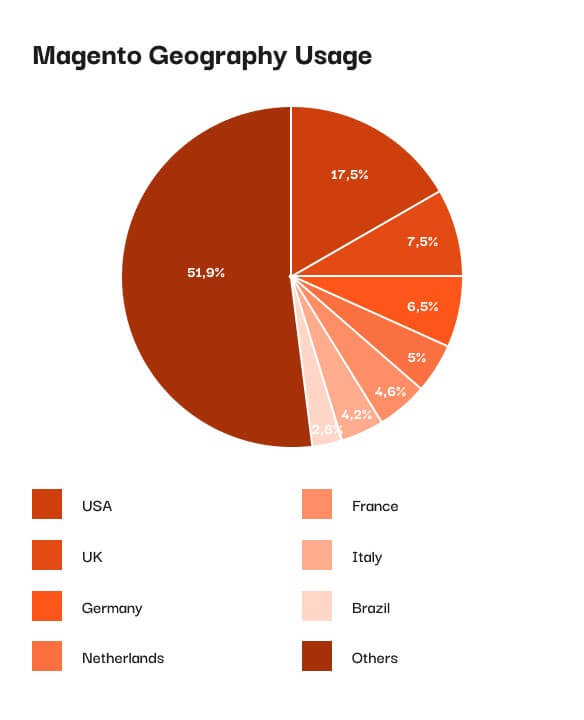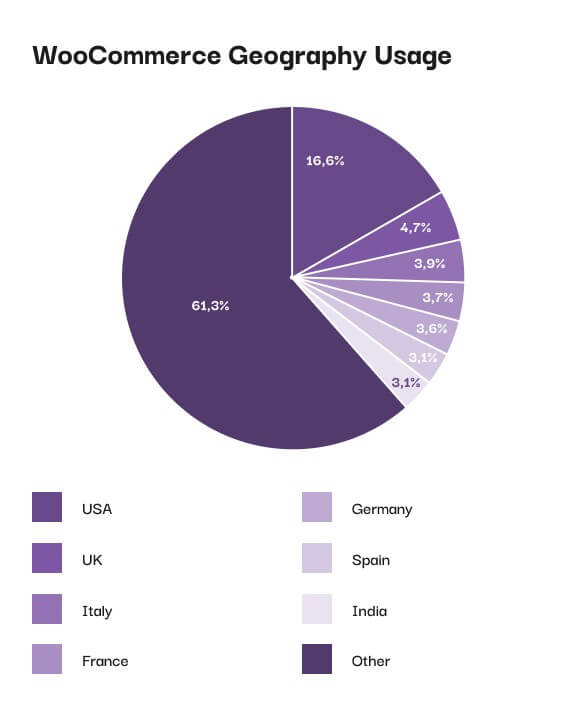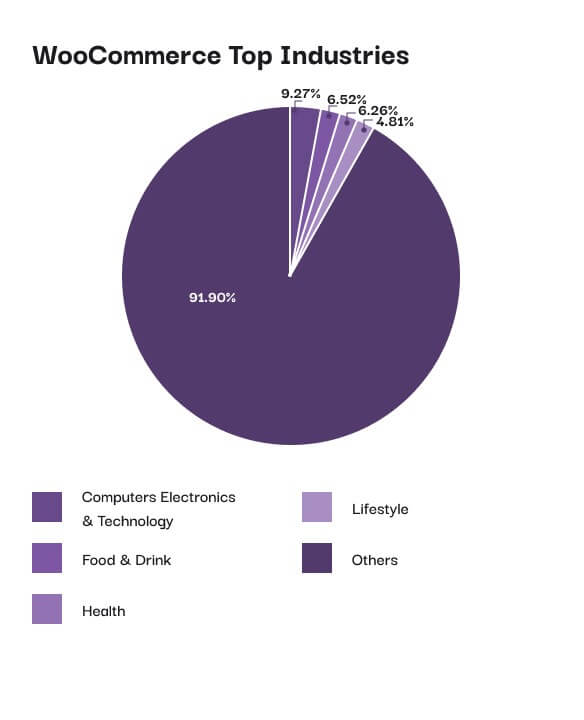There are so many ecommerce platforms available. But which one to choose? Let’s make this choice easier for you with Magento vs WooCommerce comparison.
Both platforms received decent popularity, are widely used by ecommerce companies, and provide extensive features for online businesses. But which is better for a growing business dealing with several product categories and a diverse product range? Which one has the power to support multiple internal processes, which are an integral part of an ecommerce business? Let’s find out.
General Overview: Magento vs WooCommerce
Magento Overview
Market share: According to SimilarTech, around 90,000 sites are running on Magento in 2022.
Geography: Magento is the most popular CMS in the United States and the United Kingdom. It is also a common choice for businesses in Germany, the Netherlands, France, Italy, Spain, Belgium, Australia, Brazil, and India.

Top industries: Lifestyle, home & garden, ecommerce & shopping, computer electronics, etc.

Top brands: Magento is the choice of the following worldwide-recognized brands: Coca-Cola, Ford, Land Rover, Jaguar, Seat, Timberland, Helly Hansen, Everlast, Omega, Fred Perry, Monin, Björn Borg, etc.
WooCommerce Overview
Market share: The SimilarTech report shows that over 1,000,000 sites are developed on WooCommerce.
Geography: WooCommerce is a popular choice in the United States, the United Kingdom, Italy, France, Germany, Australia, and Canada.

Top industries: WooCommerce is used for computer electronics, food & drinks, health, and lifestyle.

Top brands: Certified Comic Shop, Kalista, Singer, All Black, Nalgene, Newlyn, Daelmans Stroopwafels, Airstream Supply Company, etc.
Magento & WooCommerce: The Basics
Magento is an open-source platform with a modular and highly-customizable architecture. Magento was developed as an e-commerce solution with multiple out-of-the-box features to provide a user-friendly and intuitive customer experience.
Initially introduced as a free platform, Magento evolved into two separate solutions: Magento Open Source and Adobe Commerce.
The former remains free and has essential functionality to create a flexible online store. You can make use of its multiple available themes and pre-set features.
The latter is a paid version that offers extended functionality more suitable for enterprise-level ecommerce stores. With it, you have more control over customization, can manage B2B and B2C websites, target different geographies, and easily scale your business.
Magento is geared toward developers. You will definitely need a team of Magento professionals who can customize your e-store, integrate other systems, and personalize the customer journey. However, this makes this platform flexible – developers help tailor the website to your business needs.
WooCommerce is a free, open-source plugin you can add to your WordPress site. If you are already familiar with WordPress, it will be much easier to install the WooCommerce plugin and set up an online store. It comprises everything you need to create a full-fledged space for customers.
WooCommerce is known for its ease of use. It is beginner-friendly and goes with most WordPress themes and customizations. And what’s important is that you have total control over your ecommerce site’s appearance, features, and the products you place there.
To decide which platform will work best for you, let’s look closely at the features, performance, extensions, security, scalability, marketing, and SEO capabilities of these two platforms.
Key Features
WooCommerce features are enough if you are building a small independent e-store. It has the most common e-commerce functionality. However, you can also install additional plugins to expand the website’s capabilities.
Magento is suitable for larger businesses and can support a larger number of business operations. It has more in-built features and does not require as many plugins as WooCommerce. And if you choose Adobe Commerce, you will get more capabilities from the very start.
Performance
Website speed and performance are critical for e-commerce stores, especially when there are so many competitors in the market. Online customers are impatient and prefer to shop when pages load quickly and do not make them wait to see the product catalog, review product pages, or check out.
In the case of speed and availability rate, there is no ultimate winner in the battle between Magento vs WooCommerce. A website’s performance depends on its functionality, themes, the size of a platform, hosting provider, the number of plugins or extensions, etc.
However, the Quanta research study showed that Magento has a better performance rate than WooCommerce. On average, Magento pages load 16.6% faster than WooCommerce’s.
Scalability
Scalability is a key factor for a growing business. Companies must be ready to add more to their ecommerce platforms without sacrificing performance. So let’s see which platform wins in terms of scalability: WooCommerce vs Magento.
Both Magento and WooCommerce state that their websites can be scaled up as much as possible. However, when you add more add-ons and products to WooCommerce or Magento, they slow down your website.
It will be much easier to scale up Magento, in some sense. It will require the help of developers, but this platform allows you to be more flexible and scalable since it is built upon a modular framework. Thus, extensions added to Magento can also be scaled up, eliminating performance issues. The same with the database, which is also adaptable and modular.
WooCommerce is more limited when it comes to the ability to scale up. You can resolve issues that often affect scalability, such as poor caching, heavy download files, and inefficient coding, and you can change your hosting provider. However, you don’t have the same flexibility that Magento’s modular framework offers.
Security
Ecommerce websites store a lot of personal information as well as payment details. Sure thing, data security must be a priority for any company.
WooCommerce provides its clients with an SSL certificate and maintains its own security measures to protect websites from cyber attacks. WooCommerce is also regularly updated with security patches. These are standard security methods that are usually enough for small businesses.
On the other hand, Magento can ensure advanced security for its clients thanks to dedicated security patches. It also offers the Security Scan Tool for website monitoring, unauthorized access detection, and malware patches updates. Moreover, additional built-in security extensions help prevent break-in attempts.
Extensions
In terms of extensions, the WooCommerce vs Magento rivalry is tough. Both platforms have great opportunities for adding new functionalities. WooCommerce offers tons of free and paid plugins. And similarly, Magento can benefit from some free add-ons and has built-in extensions in its paid version, Adobe Commerce.
WooCommerce and Magento have thousands of extensions for different needs, including payments, shipping, security, accounting, support, marketing, and site optimizations. You will likely find anything you need for your ecommerce platform in respective stores.


Prices for extensions or plugins vary. Adobe Commerce has some of the add-ons included in the price. And if needed, you can buy additional extensions. With WooCommerce, you can purchase new plugins when necessary.
Marketing & SEO
Today, marketing is an indispensable part of effective sales. And your website must have blogging and SEO tools to boost visibility and brand awareness.
Since WooCommerce is a WordPress plugin, you can fully benefit from them when choosing this platform for your online store. You will get an in-built blog, SEO tools, content optimization suggestions, as well as discounts and coupon features for promo campaigns.
Marketing and SEO with WooCommerce are painless since WordPress was initially designed with blogging in mind. Plus, additional plugins, such as Google Analytics, MailChimp, HubSpot, Zapier, and others, are also available in the WooCommerce store. They can boost email & SEO marketing, as well as help with customer analysis.
Marketing and SEO with Magento are a bit more complicated. Magento covers basic SEO needs. However, you need to install a paid extension to promote your brand with blogging. More marketing extensions, such as Google Analytics, HubSpot, Atwix, MailChimp, Klaviyo, and others, are also available in Magento Marketplace.
WooCommerce vs Magento Final Thoughts
Magento is undoubtedly a more powerful platform for developing an e-store. It offers a more robust, scalable, and secure environment. You can start small at the early stages of your business and grow. Yet, you are going to need the support of a development team.
WooCommerce, as mentioned, will work for you if you have a small business. With this ecommerce platform, you won’t need much developer experience. However, if you decide to scale up, you may experience performance issues and need a professional team to assist you.
Here’s a brief recap of the Magento vs WooCommerce overview:




